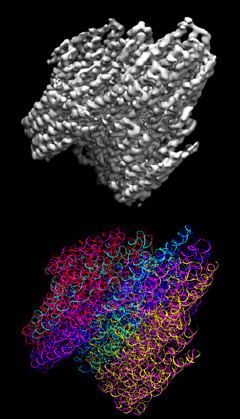 | ||
DNA origami is the nanoscale folding of DNA to create non-arbitrary two- and three-dimensional shapes at the nanoscale. The specificity of the interactions between complementary base pairs make DNA a useful construction material, through design of its base sequences. DNA is a well-understood material that is suitable for creating scaffolds that hold other molecules in place or to create structures all on its own.
Contents
DNA origami was the cover story of Nature on March 16, 2006. Since then, DNA origami has progressed past an art form and has found a number of applications from drug delivery systems to uses as circuitry in plasmonic devices; however, most applications remain in a concept or testing phase.
Overview
The idea of using DNA as a construction material was first introduced in the early 1980s by Nadrian Seeman. The current method of DNA origami was developed by Paul Rothemund at the California Institute of Technology, the process involves the folding of a long single strand of viral DNA aided by multiple smaller "staple" strands. These shorter strands bind the longer in various places, resulting in various shapes, including a smiley face and a coarse map of China and the Americas, along with many three-dimensional structures such as cubes.
To produce a desired shape, images are drawn with a raster fill of a single long DNA molecule. This design is then fed into a computer program that calculates the placement of individual staple strands. Each staple binds to a specific region of the DNA template, and thus due to Watson-Crick base pairing, the necessary sequences of all staple strands are known and displayed. The DNA is mixed, then heated and cooled. As the DNA cools, the various staples pull the long strand into the desired shape. Designs are directly observable via several methods, including electron microscopy, atomic force microscopy, or fluorescence microscopy when DNA is coupled to fluorescent materials.
Bottom-up self-assembly methods are considered promising alternatives that offer cheap, parallel synthesis of nanostructures under relatively mild conditions.
Since the creation of this method, software was developed to assist the process using CAD software. This allows researchers to use a computer to determine the way to create the correct staples needed to form a certain shape. One such software called caDNAno is an open source software for creating such structures from DNA. The use of software has not only increased the ease of the process but has also drastically reduced the errors made by manual calculations.
Applications
Many potential applications have been suggested in literature, including enzyme immobilization, drug carry capsules, and nanotechnological self-assembly of materials. Though DNA is not the natural choice for building active structures for nanorobotic applications, due to its lack of structural and catalytic versatility, several papers have examined the possibility of molecular walkers on origami and switches for algorithmic computing. The followings list some of the reported applications conducted in the laboratories with clinical potential.
Similar approaches
The idea of using protein design to accomplish the same goals as DNA origami has surfaced as well. Researchers at the National Institute of Chemistry in Slovenia are working on using rational design of protein folding to create structures much like those seen with DNA origami. The main focus of current research in protein folding design is in the drug delivery field, using antibodies attached to proteins as a way to create a targeted vehicle.
